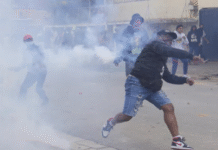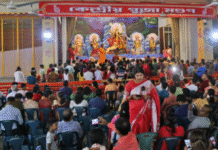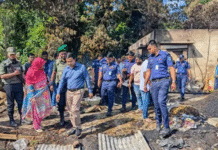Beating suspects not crimes

“Mother, seek mercy for me from the Prime Minister. Tell her that I am a regular student and that I am not involved with any political party. Please entreat her to revoke my remand. Please tell them not to beat me.” This was the plea of Rashed Khan, one of the leaders of the quota reform movement and a student of the Department of Banking and Insurance, University of Dhaka, when he got to meet his mother for a few minutes on his way to the court from police custody after completing his five-day remand.
“I was waiting in front of the office of the DB (Detective Branch) as I got to know that my Moni (Rashed Khan) would be taken to the court. My heart was shattered when I saw him. He bore clear signs of physical torture. There were black and blue marks on his cheek. There were also signs of bleeding on his face. He looked pale and very weak. I ran towards him but DB officials ordered me not to touch him. My son could only get those words out before they whisked him away from me,” says a wailing Saleha Begum, mother of Rashed Khan to Star Weekend.
Rashed was arrested for spreading defamatory speech and inciting violence and unrest through Facebook during the quota reform movement. Subsequently, he was placed on a five-day police remand—an unprecedented action in such cases. Furthermore, he was shown arrested in another case filed with Shahbagh Police Station on April 9 for ransacking and vandalising the residence of Dhaka University’s Vice Chancellor and assaulting the police and preventing them from discharging their duties. On July 8, Rashed was remanded again for 10 days in these two cases. Saleha’s account and Rashed’s plea suggest that he had likely undergone physical torture in police custody.
In fact, allegations against the Bangladesh Police of inflicting torture on persons in custody is nothing new. According to Ain O Salish Kendra, in 2017, 53 people lost their lives in custody; 20 among them were convicts and 33 were detainees. In the first half of 2018, 25 people, 14 of whom were detainees, have reportedly died in police custody. For instance, on March 12 this year, Chhatra Dal leader Jakir Hossain died in prison after spending three days in remand. Jakir’s younger sister Sultana Rajia told The Daily Star, “My brother was in good health before he was arrested. I do not know what could have happened to him in remand that he could not survive.”
Those who returned from remand revealed a horrific description of torture and abuse in the name of interrogation, as narrated in a research report in 2015 titled “Arrest without Warrant and Remand: Directives from the High Court and Reality” by Bangladesh Legal Aid and Services Trust (BLAST), a human rights and legal aid organisation. A 32-year-old detainee claimed, “I was repeatedly tortured by the police during my four-day remand. I had heard that police sometimes use hot eggs to torture people, but my experience was more terrible than that. They inserted hot red chillies through my anus. I fell extremely sick but they didn’t give me any medical treatment. I arranged my own treatment after getting bail from the court.” Another respondent of the research stated, “I was arrested several years earlier. Police didn’t inform me about reason behind my arrest. Immediately after taking me to the station, they started to beat me up. They forced me to confess that I had illegal arms in my possession. After producing me before the court, the police again took me into their custody and tortured me for three days. I was also threatened of more brutal consequences if I spoke about the torture in remand before the court.”
Star Weekend also independently interviewed some former detainees who claim that they underwent horrific physical torture in remand. According to them, the most common forms of torture are pouring boiling hot water on private parts, electrocution, hitting the joints, foot whipping (hitting the bare soles of a person’s feet), inserting hot substances through the anus and waterboarding (pouring water over a cloth covering the face and breathing passages of the immobilised detainee to simulate the experience of drowning).
One such former detainee, a 30-year-old male, says, “After five days of remand, I became so weak that I couldn’t stand on my feet. Those were the darkest days of my entire life. I had to go through unspeakable forms of physical and sexual torture. It has been three years since I was released but I still cannot carry anything weighing more than four or five kilograms. I also have to walk very slowly as injuries from my smashed toes and fingers and fractured bones still cause me excruciating pain.”
It goes without saying that torture in police remand is illegal and unconstitutional.

Bangladesh Police, however, completely denies such allegations of torture. “Taking detainees into remand is a part of investigation as sometimes it is not possible to complete it within 24 hours of detention and some complicated cases require rigorous investigation. During remand, an investigation officer is authorised to take necessary measures according to the Code of Criminal Procedure (CRPC) and Bangladesh Police Regulations to conduct the investigation. It is not true that the detainees are tortured in remand because there is no provision of torture in the CRPC and Police Regulations,” says Md Masudur Rahman, Deputy Commissioner, Media and Public Relations Division, Dhaka Metropolitan Police.
According to Barrister Sara Hossain, a lawyer of the Supreme Court and honorary Executive Director of BLAST, “Rights of the arrested and detained individuals have been enshrined in Article 33 and 35 of the Constitution. Some of these rights are: informing the arrested individual about the cause of the arrest, allowing him to consult with his/her lawyer, producing him/her before the magistrate within 24 hours, not detaining him without the order of the magistrate, and keeping him safe from all sorts of torture. Besides, Article 27 (equality before law), 31 (right to be treated in accordance with law) and 32 (right to life and personal liberty) protect the citizens from arrest without warrant and torture. However, these rights are frequently violated by the law enforcing agencies.”
When and how is remand legal?
Barrister Jyotirmoy Barua, an advocate of the Supreme Court, explains that there are strict guidelines upheld by the Appellate Division of the Supreme Court of Bangladesh which ensure that the police’s power to arrest without warrant and magistrate’s power on remand are consistent with constitutional safeguards on arrest and prohibition on torture. He also argues that neither police nor magistrates are following these guidelines.
The Supreme Court issued these guidelines on May 24, 2016 which first came as directives from the High Court on April 7, 2003 upon a writ petition filed by a group of human rights organisations and individuals following the tragic death in police custody of Shamim Reza Rubel, a student of Independent University on July 23, 1998 who was picked up by plainclothes police. The government had filed the appeal with the Supreme Court on August 2, 2003 against the High Court verdict. After 13 years in 2016, the Supreme Court upheld the High Court verdict and directives with some modifications and issued a set of guidelines to stop law enforcement agencies from making arbitrary arrests on suspicion and torturing arrestees on remand.
According to the guidelines, the members of the law enforcement agency must produce a case diary describing the case as it may be when submitting a prayer for detention; if they fail to do so, the magistrate will release the person upon taking a bond from him. The guidelines also restrict the magistrate from making an order of detention in judicial custody if the police forwarding report discloses that the arrest was made to put the arrestee in preventive detention (a detention without any criminal charge which is made just to prevent the individual from committing crimes).
Further, if the magistrate finds any material or information that a person has been subjected to torture, the magistrate will refer the victim to the nearest doctor to ascertain the cause of injury; and if the person is dead, the magistrate will refer him to a medical board to ascertain the cause of death. It has been further stated in the guideline that if it is found that the detained person has been tortured, or died due to torture, the magistrate shall take cognizance of the offence suo-moto against the officer and officer-in-charge of the police station or commanding officer of the officer without waiting for the filing of the case.
Besides, according to the directives issued by the High Court in 2003 which was upheld by the Appellate Division of the Supreme Court, interrogation of the person in remand must take place in a special glass-built chamber surrounded by grills in front of which relatives and lawyers can see the interrogation process. The High Court directives also made it mandatory to submit medical report before and after the interrogation.

“Although these guidelines established by the Appellate Division of the Supreme Court of Bangladesh must be implemented by all members of law enforcement agencies and members of the judicial services, the reality is that these directives are not followed at all,” argues Barrister Jyotirmoy Barua. “For instance, the police didn’t submit any case diary while praying for remand of the detained quota reform activists and leaders. Moreover, they didn’t submit any medical report before and after the remand as per the guidelines. When I drew the attention of the magistrate on these issues during the hearing, it seemed that the magistrate was not at all aware of the guidelines and sanctioned remand of the detainees,” he adds.
When asked whether Bangladesh Police is following the guidelines on applying for remand of the detainees, Rahman replies, “Remand is sanctioned by the court. If the investigation officer does not follow proper procedure, the court can reject his appeal and even indict the officer.”
In addition to these guidelines, in October 2013, Bangladesh Parliament enacted The Torture and Custodial Death (Prevention) Act, 2013 which has made it possible to prosecute any member of the law enforcement agencies in case of custodial death and torture
According to this act, the torturer can be punished with imprisonment for a minimum of five years or fined, the minimum amount being Tk 50,000 or both. If the detainee is killed due to torture, then the torturer can be punished with imprisonment for life or fined a minimum of Tk 100,000 or both. Those who attempt to commit, assist, provoke torture, or conspire to commit torture can also be brought to justice under this act. The accomplices of torture can be punished with two years of imprisonment or a fine of a minimum Tk 20,000 or both.
Although there are several criticisms of this law for instance regarding the definition of torture stated in the law, provisions of punishment, compensation, and protection of the complaints and witnesses, this law has made it possible to fight against torture and custodial death. However, Bangladesh Police repeatedly demanded repeal of this law because according to them it is “curbing the rights of the law enforcers” (The Daily Star January 24, 2017).
Now, the question is, if there is no provision of custodial torture in any legislation, why cannot incidents of custodial torture be prevented? The answer lies in the negligence of our government to implement the guidelines. As Barrister Barua explains, “Since the issuance of the guidelines in 2016, you will not find any incident where a magistrate found any material or information about torture in remand and where the responsible police officer has been indicted according to the guidelines. But can we say that no incident of torture in remand occurred in Bangladesh in the last two years?”
Barrister Shafique Ahmed, former minister for the Ministry of Law, Justice and Parliamentary Affairs, explains how this crisis can be solved. “All the members of the judicial service are directly under the jurisdiction of none but the Supreme Court of Bangladesh. If a magistrate fails to implement the guideline or follow the proper procedure, the aggrieved party can file a petition to the Supreme Court seeking to hold the magistrate or judge in contempt of court. This is how accountability can be ensured in the judicial service,” says Barrister Ahmed.
However, victims like Rashed, whose mother has come to Dhaka for the first time in her life, have little idea about such provisions. And, when poor, helpless victims like them face hostile treatment from the law enforcement agencies and see how indifferent the government high ups are about their sufferings, their obvious choice is to take bail at any cost and not to take the risk of filing petitions against such powerful offices of the government.
The writer can be contacted at shahnawaz.khan@thedailystar.net









